Posts tagged "bikes"
← All tags
February 19, 2024
This is a story about hopes and dreams.
In 2022, I had the opportunity to buy a 1995 Rivendell Road Standard frame—that fit me!— and build it up. I decided to go all out. With the insurance money I got from having my previous gravel bike stolen, I put a plan together with Jay from Scenic Routes.
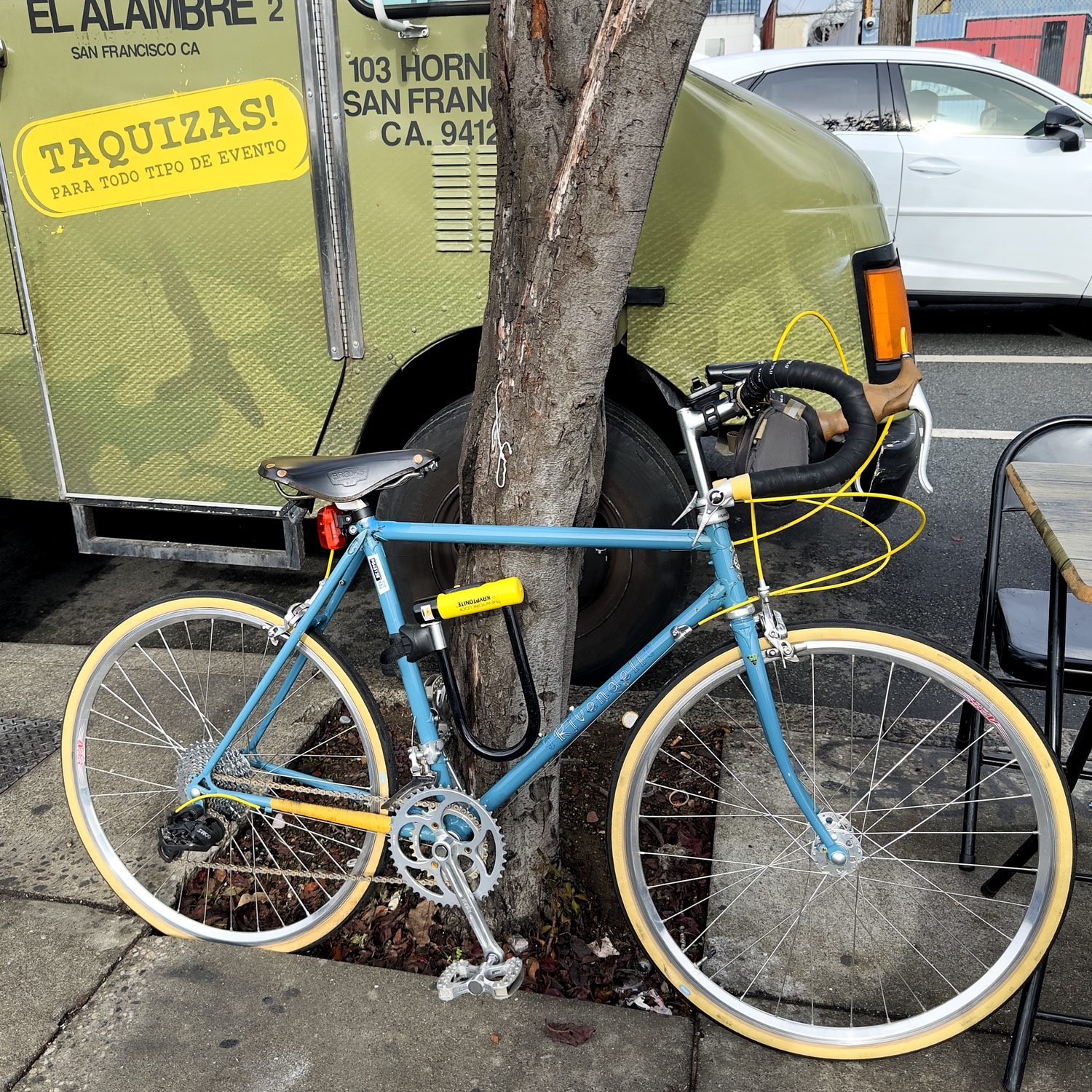
1995 Rivendell Road Standard taking me to taco trucks and beyond.
Here was the build that we planned together:
| Part |
Model |
| Handlebars |
randonneur 25.4 400mm |
| Brake Levers |
Gran Compe 202 Non Aero Brake Levers, Drilled |
| Downtube Shifters |
Dia-Compe ENE Down Tube Shifters |
| Cranks |
Rene Herse Double Crank 46-30 - 171mm |
| Pedals |
MKS Monarch |
| front hub |
Velo Orange 32 hole silver |
| rear hub |
Velo Orange 32 hole silver |
| rims |
Velocity A32 32 hole polished |
| spokes and calc |
spoke calc and spokes and nipples x 64 |
| brakes |
shimano 105 |
| cassette |
microshift 11-36 |
| tires |
26″ x 1.25″ Elk Pass Tire |
| cables |
two brake and 2 shifter |
| front derailleur |
dura ace |
| rear derailleur |
Shimano deore long cage |
| chain |
9 speed in stock |
After a few arduous months, it was finally done. I rode it, happily, for many months. I even went on a YouTube show with it.
Then early last year, the bike—along with all the bikes in my building—disappeared. My Tesla-driving neighbor had apparently left the garage door wide open, which led to someone coming in and grabbing every bike within sight. I was inconsolable, of course.
A few things gave me hope:
A few friends who know a thing or two about used bikes told me they were certain the bike would find its way back to me some day, because my bike was so unique that it would be difficult for the thief to sell; and it would be difficult for anyone thinking about buying it to not know it was stolen.
4 or 5 months passed, and I continued making sure my post about the bike was updated on Craigslist, Reddit and elsewhere.
Randomly, I got a Reddit message from someone who said he had seen my bike at Laney Market in Oakland, and bought it. He told me that he worked in bike industry and that, when he saw it at the flea market, knew for sure it was stolen, so he decided he would try to find me. We met near a BART station and he returned the bike to me (I Venmo-ed him what he paid for it, and a bit more). I had also received a few calls from people who had spotted it at Laney Market, but by the time I made it out there I could not find it myself. I'm thankful to the community and to folks for looking out for this bike for me. I love it to bits.
The bike was returned to me in a really good condition. It was almost as if no one had ridden it at all. Someone had tried to cover its distinctive lugs with ugly markers. That's mostly faded out on its own. I didn't need to do very much when I got the bike back, beyond the flat tires.
I'm now determined to ride the hell out of this bike. Thank you, bicycle gods, for looking out for me!
February 7, 2024
One of the things I love most about living in the Bay Area is the easy bikecamping we get 'round here.
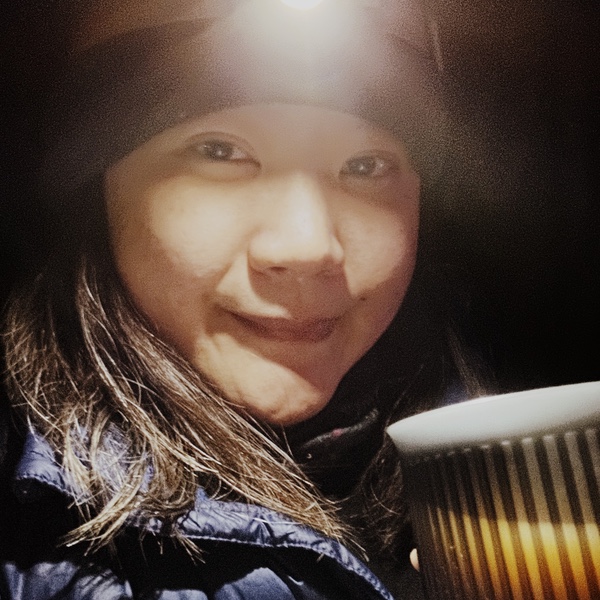
Here are some of my usual rides and camps:
Samuel P. Taylor State Park
#
The very first place I went bikecamping. While you can and should make reservations, state park rangers are likely to find space for hikers and bikers without any.
"You can camp among redwoods, bike along the creek, explore easy-to-moderate hiking trails, watch salmon spawn, relax in the shady picnic area, and learn the story of its namesake pioneer. When you’ve finished all that, more adventures await just next door at Point Reyes National Seashore." (from park website)
State facilities here are very good: bring plenty of quarters for camp showers. Lots of water.
Plenty of hiking opportunities as well: bring a lock, lock up your bike, and go on a walk.
A very popular camp site near San Rafael. Tent camping in a fairly secluded area with 15 miles of trails. Bring quarters for showers. Definitely book, but they say they have two campsites for hikers and bikers. Firewood available for sale so cooking is relatively easy. Bring a wagon to ferry firewood if needed.
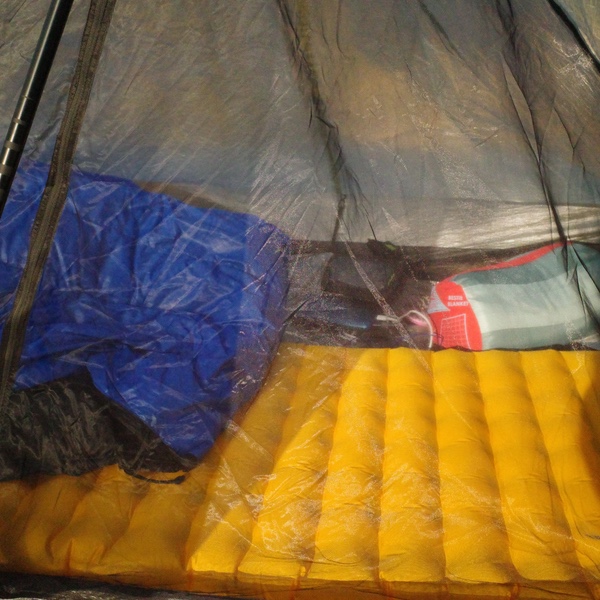
The ground here is 'hard pack' and I found it very difficult to pitch ultra-light tents (the kind you prop up with a hiking pole). I will bring a normal tent next time.
The 'wildest' camping I did (until I did Yosemite in 2021): no water source, very basic facilities (just toilets, no shower; water from some spouts). But right by the ocean (at Wildcat campground).
This is a much longer ride than the other two, so I would break it up unless you know you're a relatively strong rider.
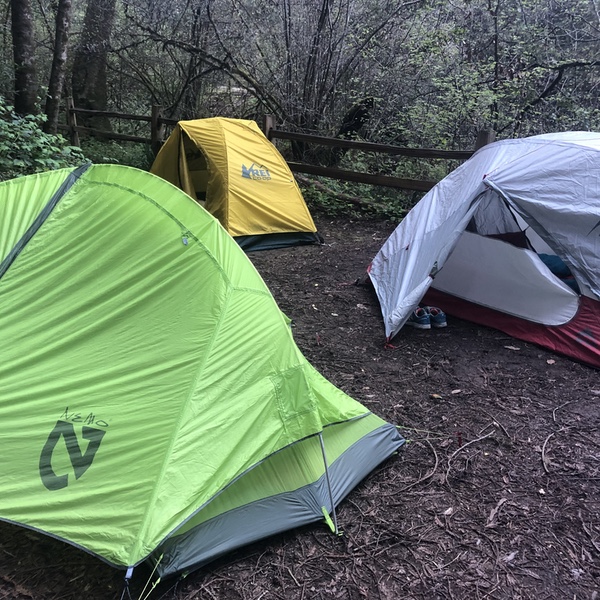
If you haven't ridden long distance, or you're on an unfamiliar bike (like a rental), I would do shorter day trips across the Golden Gate Bridge and try to do 'credit card bike camping' first. These hills are no joke. If you're relatively confident and / or you're going with experienced bikecampers, then it's a super fun experience!
March 13, 2023
I was always a big city person. I liked nature, but not excessively. Now that I'm almost 5 years into being a Californian, that's starting to change. I don't just like the outdoors, I love it. I survived (and thrived) at a five day backcountry Yosemite backpacking trip with no toilets or showers. I scaled Half Dome. I go bikecamping a few times a year.
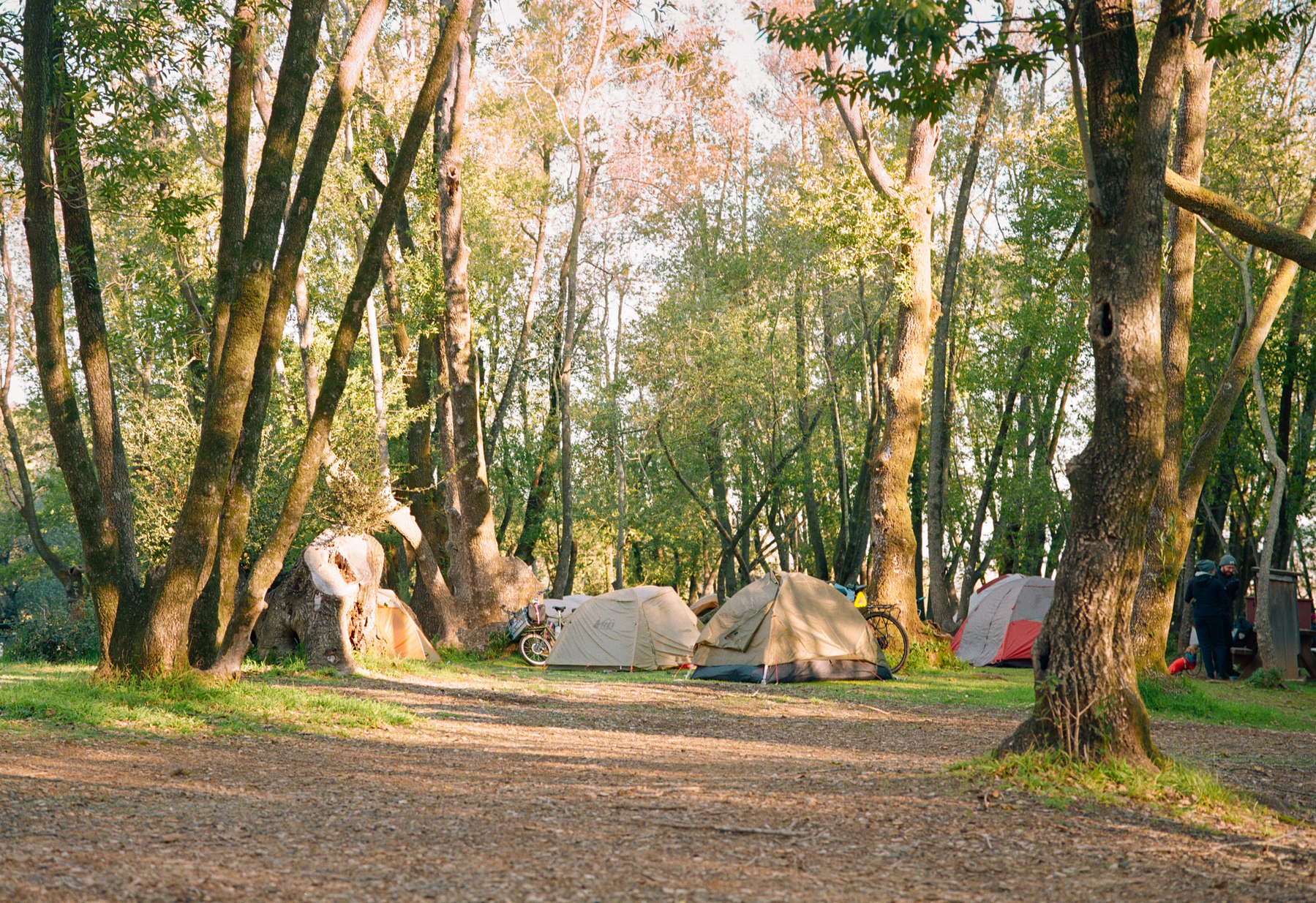
Shot on Fuji GW690II on Portra 800, developed and scanned by Underdog Film Lab
That's one of the joys of living in Northern California, and in being in San Francisco specifically. I can bike to the Golden Gate Bridge in 20 minutes or so, and cross it in the same time (I don't bike very fast). Across the bridge, I can go west to the Marin Headlands or straight into the small towns of Sausalito, Mill Valley, or as far as San Rafael or San Anselmo where I have some favorite spots for food and snacks; and in some areas, set up camp if I want.
I'm thankful to have the opportunity to experience this, and to have found a bunch of folks who will come experience all of this with me.
May 30, 2012
In my mother tongue we have a brilliant turn of phrase. Geh kiang. Separately, they mean fake clever. Together, it means some approximation of 'smart alec', but that's not quite good enough. It's hardly translatable at all. 'Smart alec' does not embody the degree of stupidity we are usually referring to when we say 'geh kiang'.
My mother will tell you I embody geh kiang, every bit of me.
I was especially geh kiang when I packed up my bags and bicycle, mostly under stressful circumstances, in order to take them somewhere.
Why did I bring a bicycle to northern Europe? I found myself wondering that all throughout my Nordic escapade. I wondered the loudest and grumbled the most when it was time to pack up my bags and my bicycle all over again. Five times. I know, I counted.
I packed up my bags and my bicycle when I had to move, when I had to get in a plane, when I had to jump into a train, when I had to do all of that entirely by public transport (cabs are totally out of the question in Europe!) and onto train platforms and then into trains.
It was difficult, to say the least. Lucky for me — and my sanity — my love for cycling, and the relative benefits of having one's own bicycle in a foreign place, far outshone the logistical barriers. I will probably do it again.
When you commit to having such a piece of equipment by your side of the entire duration of your trip, you're committing to a relationship that will be the primary relationship, one that will be far more important than the by-now boring concept of luggage. You have to look after it. Endure the glances. Fight for it at airport check-in desks. Hold it, dance with it, around the feet of heavily pregnant commuters and swerving around nervous people, trying your best not to jab anybody with your hulk of a piece of equipment.
So what happened? In a nutshell,
I broke my bike
Finnair treated my bike brilliantly. I flew them three times: to Helsinki, to Stockholm, back from Copenhagen. All three times my bicycle more than survived, and the entire experience was very easy. I highly recommend Finnair for their quick, no-nonsense flights to Europe from Singapore. Helsinki Airport is also my new favourite airport.
I, however, was very stupid. I tried to fix what I thought was a loose nut, myself. Being no bike mechanic, I promptly broke the weirdest little part I could break — the plastic doohickey in the stem of the folding post of my bike. Without it, my bicycle could not stay folded. Foldable bikes like mine haven't taken off in that part of the world at all. Even though the Finns speak amazing English, most people anywhere have never heard of a plastic doohickey. Not unless you are very familiar with foldable bikes of the Dahon make.
Somehow, I managed to find an excellent bicycle shop where its owner and mechanics were super helpful. Since it's not even a part that my bicycle's manufacturer offers for sale, it seemed pretty dire. Thankfully, a quick-thinking mechanics with extraordinary ability in plastics (he had a degree in plastics engineering) took a look at the broken plastic bits, and he made a brand new doohickey for me. That entire process took a week so I had to go to Tallinn without my bicycle, but I was relieved that I wouldn't be travelling around with an unridable piece of junk for the next 3 weeks. More glad that it got fixed. I got lucky.
I had to be rescued by Swedish police
Not something I care to repeat ever again, but.. what an experience.
I was cycling along the bike lanes from Kungsholmen to Stockholm Central, happily zipping along at 25km/h with an air of familiarity. I was starting to really get where things were in Stockholm, and I'd had some amazing city rides. Seems like Stockholm Central hates me for some inexplicable reason. The last time I was there in 2010, I got locked out of Stockholm Central for many hours while my luggage was locked in.
This time, I guess I missed the sign that said "IF YOU ARE A BICYCLE, GO LEFT! NOT STRAIGHT!"
I went straight.
I realised something was amiss when I started descending down a steep flyover. I saw many heavy vehicles. I saw that I had no way to filter right (they ride on the right) without being in the middle of oncoming, converging traffic from another steep flyover. I jumped out. I saw that I could not go back up, and that there was no way I could walk off that bridge (water, water, everywhere).
I jumped onto my bike and kept going.
At some point it dawned upon me in my puny little brain that if I went any further, I would be bus chow in the middle of the underwater tunnel that crossed islands into Södermalm. I got out.
I don't know what I was thinking — probably nothing — I remember I was extremely calm. I called a Swedish friend, who could not help; I texted the Swedish friend I was riding to meet and told her I'd be late, that I'd explain later when I saw her.
Mostly I just stood by the side of the road and looked pathetic, I think.
A Stockholm city police car came within ten minutes, bundled my bicycle and its stupid owner into the back of the car, and drove me to Stockholm Central. I figured motorists might have called in to tell them that an Asian tourist was dangerously obstructing the lives of motorists on the highway by looking pathetic and helpless.
(They did confirm that they received calls about me, which is why they came; I didn't care to ask what had been reported!)
Stockholm police's parting words to me: "you should take a photo and show it to your friends."
Damn malu.
I had to carry a ton of weight every step of the way
Let's just say travelling with a bicycle, no matter how light, is not for the faint of heart. I only moved all my bags and the bicycle when I moved to a new city or went to the train station or airport, but when I moved, I moved.
One of the last minute decisions before leaving for Helsinki was that I would bring a silly little trolley with me. The kind that aunties go to the wet market with: the flimsy, plastic ones that are given out free at computer fairs or promotions. I don't know how I managed without it. Although my Dahon D7HG is quite tiny when folded, and it was also in a soft bag, the overall package including the paddings, foam and bubble wrap made for an uncarry-able package. I also had my large backpack and camera backpack. Why didn't I just pack it in a Samsonite case? I've tried that many times, each time to devastating results. First, dismantling the bike is pretty easy. Getting it to fit isn't. Unlike most other 20″ Dahon bikes, the D7HG Vitesse that I have has a large rear fender. It is close to impossible to remove, and without removing it, the bicycle does not fit into any luggage. It also has a hub gear, which makes it difficult to remove the rear wheel. More importantly, because of the hub gear and the rear fender, I'm not able to confidently put it back. I decided to avoid that nightmare this time. mrbrown and Ryan helped me zhng a makeshift soft bag carry method. It served me well.
Eventually, I gave up on the lousy trolley and went to a trolley superstore in Stockholm (yes, there is such a thing!) and purchased an amazing, sturdy, well-made Swedish trolley.
Would I do it again? Yes, absolutely! That was my first time travelling with my bicycle. To be honest, I don't think I was ready for it. I'm lucky in that I didn't get flats, I didn't need to change tubes (though I brought them anyway), that I didn't need to remove my wheels or do any repairs of any sorts on my own (other than the plastic doohickey incident). I'm no bike mechanic. I'm a little stupid about those things, in fact. I will get better at it because I now know what and where are the gaps in my knowledge.
I had an amazing time on the bike.
The Nordic countries are light years ahead of us in terms of cycling as part of the urban landscape. It was such a joy to ride there, especially in Copenhagen. Real bike lanes, bike traffic lights, an entire culture and city where cycling was a real, and sometimes the only, way of life. It was liberating.
Before going, I was quite shaky on the roads. I did not like the idea of riding on the roads in Singapore as I was not confident enough to do it. Because I got so much mileage on the roads of Copenhagen (breezy sweat-free 40km days were typical), I learned many things about what I needed to know from them. I now ride on the roads of Singapore regularly, and don't find it particularly difficult, although there are some challenges to be mindful of (car-dooring, for example).
Since I got home to Singapore, there's been a lot of talk about how public transport has become absolutely terrible. I agree it has deteriorated substantially, but my own personal way of getting around that problem is to ride more and talk less. I would be quite happy to cycle-commute at least 40% of the time in Singapore. Next time I travel, I am taking the bike with me again. Anywhere. Everywhere.
Super Geh Kiang Me.
May 10, 2012
I'm home now of course, whatever home means, and I've been retelling a couple of stories. The same ones, but many of them, just because I've had such a crazy time in the Nordics.
This one isn't very much of a story. Just a little tale that, once again, shows you how crazy we Asians are about our food.
I spent the first three weeks of my big Scandinavian/Finnish vacation on my own, and/or with friends from that region. In the last week, a friend from uni came to meet me in Copenhagen.
We did stuff, mostly in this order:
Eat. Drink. Eat. Drink. Eat. Cycle. Eat. Drink. Eat. Bring our bicycles to Sweden.
To buy chocolate cake. From a supermarket. She'd been on student exchange in Sweden, now lived in Geneva, and missed Swedish supermarket chocolate cake terribly. I'm sure it's nice and all, but damn if I ever go to another country to buy chocolate cake again.
April 8, 2012
I can't say I've been away from my phone or Mac for more than 24 hours, not at any point in the last 10 years. I can't say I have at all. They feel like such natural extensions of my arm, they are almost artificial appendages themselves, not just of my body but also of my brain. I needed to switch off and I needed a drastic way to do it.
Which is the backstory behind why I found myself living in a hut like the above.
170 km and 2 hours northwest of Stockholm, lays a little town called Skinnskateberg. Its pronunciation eludes me, and still does; somewhere between a huin and a hun instead of skinn. I'll take whatever you throw me, Sweden, but your compound sounds and accents are something I'll never get (I've just learned how to pronounce Nässjö… Promptly forgot it too).
When some Stockholm friends wanted to know my weekend plans, I told them I was going to be in Skinnskateberg, only to find most of them had never heard of it. I'm pretty sure it wasn't my pronunciation too, because I showed it to them on the map.
I was only headed there because of one thing: my need to be one with nature, in a way I knew how.
Ever since I got sick, I've been struck with the overwhelming need to go be one with nature. I can't explain it, and I can't reject it. After rejecting nature all my life (damn the insects and sweatiness of the tropics), I now want to do it all: camp, start fires, cook in the open, fetch water from natural water sources, and whatever else my city slicker mind romanticised.
So off to Skinnskateberg I went. Why there, of all places, instead of the far north? My metrics for selecting this place were simple: I didn't want to freeze my bits off, didn't want to have to pack snow shoes, knew I couldn't pack a winter-ready tent or sleeping bag (can't justify the cost of one), and I needed to be close enough to the middle to travel south to Malmö afterwards.
Which left just one place: Kolarbyn, near Skinnskateberg.
I wanted to go to Kolarbyn because it promised no electricity, no running water, and a series of huts that resembled hobbit holes, to my untrained eye.
Of course they were just replicas of the huts that the charcoal-burners of the region once lived in, hundreds of years ago, first built to educate the modern crowd about the area's history after the industry died, then turned into the eco-lodge it now is.
Kolarbyn proudly advertises itself as "Sweden's most primitive hotel", and they'd be right.
I booked myself on a two night stay there. Though I freaked out a little when I was told I would be alone all throughout the three days, things quickly worked out when I found Roxanne, an ex-classmate now working in Stockholm, would join me on my unconventional Easter break.
I was enamoured by the romance of the whole set up, but I worried about the details: how would I do with starting fires? What would I eat? How would I chop wood? What water would I drink? How would I even get there? I wrote emails to Andreas, the owner of Kolarbyn, pleading Asian virginity in the Scandinavian outdoors, and asked him to please show me how to do everything once. His Swedish efficiency of language and character was a simple, reassuring "don't worry about anything."
As it turned out, Andreas himself is ex-Swedish military, almost like a more realistic Bear Grylls (arguably better looking too). I mean, the man teaches courses teaching people how to start fires without anything, how to forage, and survive in the cold wilderness — I could not ask for a better teacher. He had me starting fires successfully in something like 5 seconds. Which just does not happen with me, usually. With non-digital skills I usually have the mental and psychomotor facilities of a five year old child, possibly worse.
He showed me the stream, from which I would fetch water, in which I would wash my cooking utensils; at which I could optionally clean myself, an option I would decline as I did not want to go home in a freezer (not to be morbid, but I'm just learning to deal with the cold and I really need more time when it comes to being in a frigid and cold body of water).
The communal fireplace was where all the cooking would take place. Though I was alone on the first night (Roxanne was to join me the second morning), I was lucky that I had a Swedish couple for company. I could not have asked for a more Swedish experience: we shared cans of Sofiero, they fed me grilled choco-bananas, and one of them even worked with Roxette. I cooked a simple pasta with mushrooms and asparagus, and dinner I made myself has never tasted as wonderful. The wilderness helps you redefine everything, including food — slow food with slow sources of fuel is indefinitely slow, slower, slowest.
My little hobbit hole, all mine for the first night, was called Botvik. All the huts have old names — such as Olof. Mine, Botvik, sounded less of a hulk than Viking-sounding Olof, and more of a bumbling little Viking version of Baldrick, which suited me fine. The Swedish couple complained that the huts were smaller than they looked online. Since I was expecting, and hoping for, a hobbit hole, Botvik was my idea of a dream come true.
Sheepskin was laid out on each side, on which a warm, winter-ready sleeping bag would go. The fireplace was a small, but sturdy little box that would be my best friend for the next two nights. A large stone apparatus enveloped the fireplace, and I came to think of it as a convection oven for my warmth.
I was worried I would be cold, but I was far from cold. The fires I started, and nurtured in Botvik were enough to keep me plenty warm at night and to keep me returning to all through the day. I was especially happy to return to the warmth of my hut after a morning hike to the compost toilet, and after the temperatures sank at nightfall.
Can it be that we have a genetic disposition to watching fires, and to wanting to make them bigger? Asked another fellow camper the next night. We had no answer, Roxanne and I, for we were busy learning about snus and stuffing our faces with soup and pork, but I certainly think he has a point.
Having never come close to a fire, or a fireplace before — I mean I do come from that breed of urbanites for whom sparkles are not good sounds, and who feared fire — fire became my best friend. Not necessarily in a pyromaniac sort of way. Fire draws you, in an elusive but unforgiving way. You can't not look at it. You need it. Everyone can have it, but not everyone can build the right kind of fire. It sounds base and primal, but it made me think about what little our primitive ancestors had and how they made use of what they did have; fire really does change everything. Not having my phone or Mac around was totally okay, then; we joked that every time we go out camping we sit around fires watching wilderness tv.
It's a channel I'm starting to get used to, I think.




